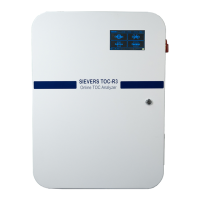COMMUNICATION BOX WIRE CONNECTION
. . . .. . . ... .... .... .... ..... ..
Sievers TOC-R3 Operation and Maintenance Manual
DLM 95000-01 EN Rev. A 72 © Veolia 2023
Communication Box Wire Connection
Connect the Communication Box to the Analyzer
NOTE: If using the Air Box, ensure the Air Box power wiring connections have
been completed prior to connecting the Communication Box to the Analyzer.
For more information, see “Connect the Air Box Power Wires” on page 70.
1. Connect the Right Cable Connector (12-pin connector on top of the Communication
Box) to Port 13 on the bottom of the Analyzer enclosure. See Figure 3-5 on page 70
and Figure 3-3 on page 65
.
2. Next, connect the Left Cable Connector (12-pin connector on top of the
Communication Box) to Port 12 on the bottom of the Analyzer enclosure. See
Figure 3-5 on page 70
and Figure 3-3 on page 65.
NOTE: The Right Cable Connector (Port 13) carries power to the
Communication Box power rail from the Analyzer. See Figure 3-5 on page 70
STEP 4: CONNECT THE COMPRESSED GAS SOURCE
The Analyzer requires low-CO
2
, TOC-free gas as Carrier Gas. Depending on the Analyzer
configuration and any Options and Accessories purchased, the compressed gas will be installed
differently. Follow the directions for your Analyzer configuration. If using an external air
connection, ensure there is an appropriate Pressure Regulator (maximum of 1 bar, 14.5 psig)
and dedicated Shut-off Valve installed nearby. The Analyzer Carrier Gas Inlet (Port 9) uses 6mm
OD, 4 mm ID Carrier Gas Tubing. Cut the Carrier Gas Tubing with a tubing cutter to length for
your environment and configuration.
If Using Nitrogen:
Connect the Nitrogen source Carrier Gas Tubing to the Analyzer Carrier Gas Inlet (Port
9).
If Using Zero/Synthetic Air:
Connect the Zero/Synthetic Air source Carrier Gas Tubing to the Analyzer Carrier Gas
Inlet (Port 9).

